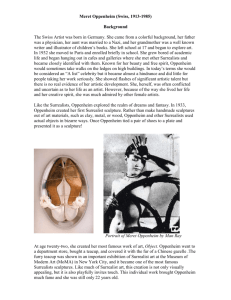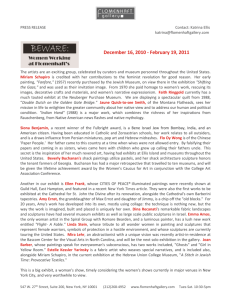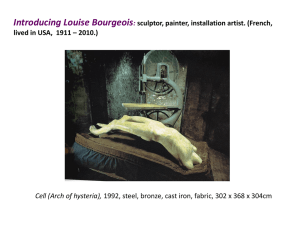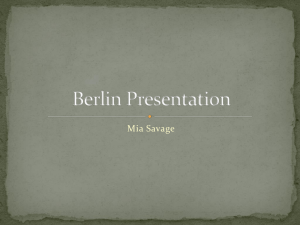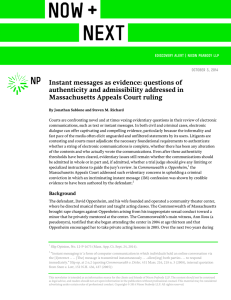Treasures, Back Together
advertisement
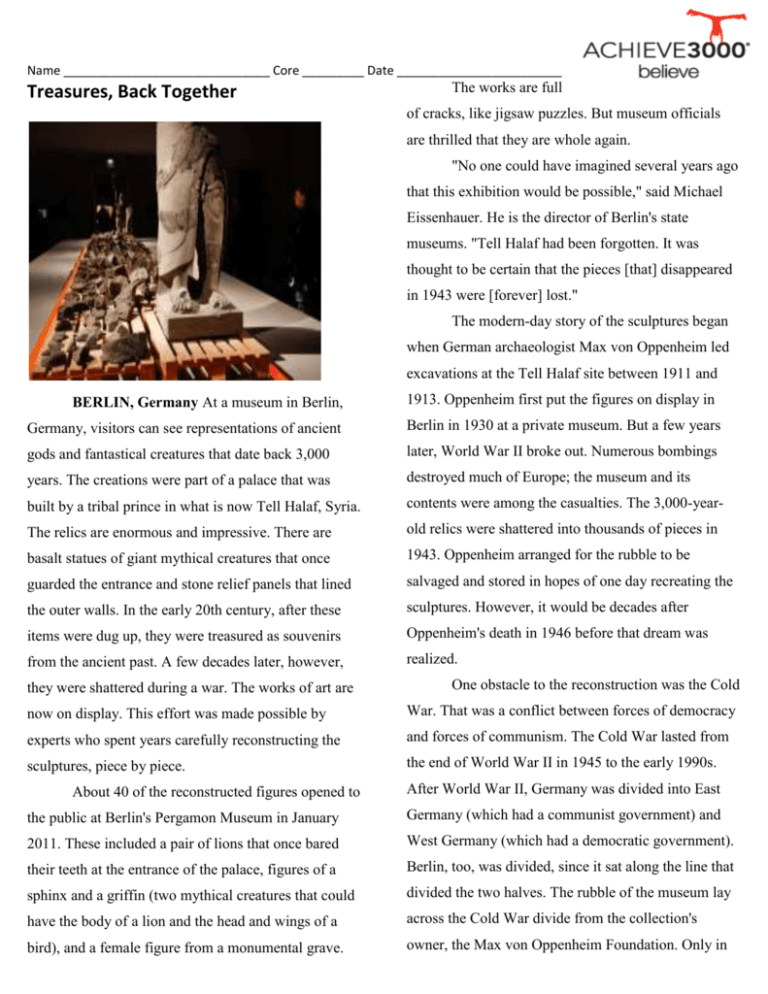
Name ______________________________ Core _________ Date ________________________ Treasures, Back Together The works are full of cracks, like jigsaw puzzles. But museum officials are thrilled that they are whole again. "No one could have imagined several years ago that this exhibition would be possible," said Michael Eissenhauer. He is the director of Berlin's state museums. "Tell Halaf had been forgotten. It was thought to be certain that the pieces [that] disappeared in 1943 were [forever] lost." The modern-day story of the sculptures began when German archaeologist Max von Oppenheim led excavations at the Tell Halaf site between 1911 and BERLIN, Germany At a museum in Berlin, 1913. Oppenheim first put the figures on display in Germany, visitors can see representations of ancient Berlin in 1930 at a private museum. But a few years gods and fantastical creatures that date back 3,000 later, World War II broke out. Numerous bombings years. The creations were part of a palace that was destroyed much of Europe; the museum and its built by a tribal prince in what is now Tell Halaf, Syria. contents were among the casualties. The 3,000-year- The relics are enormous and impressive. There are old relics were shattered into thousands of pieces in basalt statues of giant mythical creatures that once 1943. Oppenheim arranged for the rubble to be guarded the entrance and stone relief panels that lined salvaged and stored in hopes of one day recreating the the outer walls. In the early 20th century, after these sculptures. However, it would be decades after items were dug up, they were treasured as souvenirs Oppenheim's death in 1946 before that dream was from the ancient past. A few decades later, however, realized. they were shattered during a war. The works of art are One obstacle to the reconstruction was the Cold now on display. This effort was made possible by War. That was a conflict between forces of democracy experts who spent years carefully reconstructing the and forces of communism. The Cold War lasted from sculptures, piece by piece. the end of World War II in 1945 to the early 1990s. About 40 of the reconstructed figures opened to After World War II, Germany was divided into East the public at Berlin's Pergamon Museum in January Germany (which had a communist government) and 2011. These included a pair of lions that once bared West Germany (which had a democratic government). their teeth at the entrance of the palace, figures of a Berlin, too, was divided, since it sat along the line that sphinx and a griffin (two mythical creatures that could divided the two halves. The rubble of the museum lay have the body of a lion and the head and wings of a across the Cold War divide from the collection's bird), and a female figure from a monumental grave. owner, the Max von Oppenheim Foundation. Only in the 1990s, after Germany became whole again, did reassemble some of the items because the pieces were officials start examining whether the sculptures might just too damaged. be restored. About 25,000 of the 27,000 fragments of The resulting exhibition, "The Tell Halaf rubble were reassembled with the help of Oppenheim's Adventure," will be open until August 2011 and photo documentation of the excavation site. The includes palettes of the remaining rubble. Eventually, restoration took about a decade. Experts were unable to all the statues, reliefs, and pieces will be put into the museum's permanent collection. Dictionary 1. casualty (noun) a victim of an accident 2. communism (noun) political system in which all property belongs to the government and profits are shared by all 3. excavation (noun) removing dirt from a site, often where objects from the past might be found 4. comply (verb) to obey 5. restoration (noun) when something is put back the way it was before Multiple Choice: Circle the letter of the choice the best completes the statement. (2 points each) 1. Based on information in the article, which of these must have happened third? A. Archaeologist Max von Oppenheim excavated a number of 3,000-year-old statues. B. The Cold War began a long conflict between communist and democratic governments. C. Archaeologist Max von Oppenheim put a collection of artwork on display in Berlin. D. World War II broke out and numerous bombings destroyed much of Europe. 2. What is this article mainly about? A. Max von Oppenheim was careful to protect his artwork from damage during wartime. B. Some pieces of the Tell Halaf statues were too damaged to put back together. C. Works of art dating back 3,000 years were rebuilt and are now on display. D. A palace with giant statues of creatures was built 3,000 years ago in what is now Syria. 3. The reader can infer from the article that ________. A. Max von Oppenheim wanted the statues to be split up and displayed at modern castles. B. Max von Oppenheim felt the works of art were important to reconstruct and preserve. C. Max von Oppenheim felt that the statues should be hidden from public view. D. Max von Oppenheim thought it was necessary that the works of art go back to Syria. 4. Which is the closest synonym for the word relic? A. Dwelling B. Artifact C. Portfolio D. Slogan 5. This article would be most useful as a source for a student research project on __________. A. The impact of the Cold War on Europe B. Major archaeological restorations C. The causes and effects of World War II D. Significant events in Germany history 6. The article states: The 3,000-year-old relics were shattered into thousands of pieces in 1943. Oppenheim arranged for the rubble to be salvaged and stored in hopes of one day recreating the sculptures. Which would be the closest synonym for the word salvaged? A. Discarded B. Engraved C. Scoured D. Recovered 7. Which question is not answered by the article? A. Where were the restored Tell Halaf sculptures placed on display? B. How long did it take to recreate the artwork from thousands of pieces? C. How did experts figure out how to put the artwork back together? D. What did Oppenheim do in his lifetime, other than find the Tell Halaf artwork? 8. The author probably wrote this article to _________. A. Describe the people who lived in Syria 3,000 years ago B. Convince the reader that the Tell Halaf artwork is worth seeing C. Share the process that led to the current display of the Tell Halaf artwork D. Explain why museums in parts of Germany were bombed during a war Opinion Question: Now that you have read the article, indicate in the space below whether you agree or disagree with this statement. How important was it to put the statues and other items from Tell Halaf back together? (5 points) Thought Question: In the space below write a summary of today's article. (5 points)
